|
|
 |
 First First
 Previous
2-8 of 9
Next Previous
2-8 of 9
Next Last
Last
|
 |
Reply
 | | | From: Joel | Sent: 10/11/2006 1:10 PM |
"How did we survive back then?"
A few weeks ago I went to a night White Sox game with a friend and his nine year old and five year old sons. The game was good, the weather was great, and the Sox were victorious. It should have been a very enjoyable experience. One factor, though, made this a less than perfect evening. One man, just one row behind us and a few seats over and one young woman, two rows ahead of us, were smoking. Here we were in an outdoor stadium with only two people smoking in our entire section. A section of probably over 100 people. It seems like it should have been a minimal exposure. Somehow though, every time they lit up, the smoke came right at us. For those few minutes when either one of them was smoking a cigarette, my throat burned with every breath I took. I thought maybe it was just me, but then the nine year old turned to me and complained that the smoke was really burning him too. A few times when they both lit up simultaneously, the smoke got so bad that I got up with the nine year old and took a walk through the concession area so we could avoid the irritation. I wondered how many other of the 100 or so people not smoking around us were having a similar experience created by these two smokers. Some people may have left the game bitter with the feeling of resentment that two people could be so selfish and inconsiderate, interfering with the enjoyment of so many others. I didn’t think that. I truly believe they had no idea that their smoke was irritating adults and children all around them. Even if they had been told, I don’t think they could possibly believe it made us feel as bad as it did. They would think it was just another fanatic trying to infringe on their right to exercise a private practice that delivers a few seconds of personal pleasure. It is not my purpose in this particular letter to debate the fact that the smoker is not really feeling pleasure, rather, just alleviating the pains of withdrawal. It is also not my intent to belabor the point about how two people could ruin the evening for so many others. To the contrary, these two smokers heightened my awareness as to how far we have come as a society. If this was 30 years ago, over half of the men and over a third of the women would have been smoking at any given ball park in the country. If two people could produce enough smoke as to make me and the people around me feel so bad, it must have been 10 or 20 times worse. How did we survive back then? I do remember when I was a child having to leave certain events because the smoke exposure was so concentrated and irritating. You couldn’t find a place to walk around to avoid the smoke for a few minutes because the smoke was everywhere. You couldn’t even say anything about it—back then it would have been considered terribly impolite to have raised the issue. It is only by remembering how terrible it was that you can start to appreciate how far we have come. With the exception of two people, here we were virtually surrounded by nonsmokers and ex-smokers. These people were not restricted from smoking by rules or regulations. Each and everyone of them had a choice. They could smoke like the one man or the one woman, or they could not smoke like everyone else. Ninety percent of them were choosing not to smoke. Those who had never smoked just take it for granted. Even most of the ex-smokers were not sitting and thinking how fortunate they were to be able to sit through a game without needing a cigarette. They, too, just take it for granted that they don’t smoke anymore. And the two smokers were probably oblivious to the fact that they were the only ones smoking in their immediate vicinity. I think we can see the day coming where no one will be smoking in an outdoor stadium. Wrigley Field already eliminated smoking in the park except for rest rooms. It is also becoming apparent that indoor public smoking will soon be gone. Most will not be smoking by choice. A few will have it regulated from them. We will sit and watch a game, go to meetings, eat in restaurants, stand in theatre lobbys and not think about how no one is smoking. We will just take it for granted that people do not expose other people to their cigarette smoke anymore. Children will no longer be irritated by adults around them having to feed a physical craving. They will never have known what it used to be like to be assaulted by secondhand smoke. We, on the other hand, should never take it for granted that we are no longer assaulted by the smoke of others. We should think back to the days when a lot of people smoked in these places, or even back to the time period that we are in now when only a few people were smoking in public. We will feel very appreciative that we no longer have to be exposed to the risks and annoyances posed by other people’s smoke. You should also think back to the days when you were the smoker effecting people around you. Even though you never realized it at the time, you were hurting yourself as well as the young and old all around you. You can’t do anything today to change that past—but your focus should now be on never exposing yourself and those around to such discomfort and possible dangers. So that you may never again have to face such personal risks or feelings of guilt again, always remember, to stay smoke free - NEVER TAKE ANOTHER PUFF! |
|
Reply
 | | | From: Joel | Sent: 10/11/2006 1:10 PM |
Recently, a successful graduate called me complaining that she needed a cigarette. When I inquired as to why she needed to smoke, she said that there were many problems at work and she felt that a cigarette would calm her down and make her better able to cope with the current sutuation. She went on to explain that the woman who sits across from her is always smoking which futher enhances her cravings to take a cigarette. I asked her to describe the lady who was always smoking around her. She said, "She is a co-worker who is really neurotic. She is always a nervous wreck. We have the same boss, and he is the source of much of our tension." There seemed to be a great inconsistency in her story. She needed to smoke so she could calm down. She saw this lady smoking which made her feel the need to smoke even more. I could understand if her smoking companion was always calm and tranquil when confronted with unbearable stress. But to the contrary, "She was NEUROTIC". It was apparent in her case that cigarettes were not an effective stress reducing technique. Upon realizing the simple inconsistency in her story, she laughed and realized that cigarettes were no answer to dealing with her stress. Often when an ex-smoker sees another person smoking, they wish they too could have a cigarette. They may automatically think how much the person is enjoying that cigarette. The fact often is that the person may not like the particular cigarette or even realize they are smoking it. They are simply maintaining a deadly addiction, trying to avoid nicotine withdrawal. Ex-smokers should consider how while they were still smoking they used to envy people who quit cigarettes. No matter which situation you are in, a smoker observing an ex-smoker or visa versa, the other side has its appeal. The ex-smoker has the great advantage. The ex-smoker can go back to smoking any time she wishes. The smoker cannot always quit. The ex-smoker will go hours, days and eventually weeks without thinking of a cigarette. The smoker is constantly reminded by family, friends and associates of their socially offensive habit. So, next time you observe a helpless smoker maintaining this deadly habit, have pity on them. If they ask how you kicked it, share with them the philosophies we taught you. That may be all the assistance they need. If they need more help, they can always come to see us. We wish you luck in helping those closest to you quit this dangerous addiction. Once they break free, always reinforce the one concept which can guarantee continued success in staying free from cigarettes. Make sure they understand to Never Take Another Puff. | | |
|
Reply
 | | | From: Joel | Sent: 10/11/2006 1:11 PM |
Ex-smokers are often tempted when watching others smoke. Spending time with a specific friend and watching them smoke may be a trigger especially if it was the most time you had spend with the friend since you quit smoking. The first time you have any new experiences, even if smoking is not part of the ritual, the thought for a cigarette will seem like a natural part of the ritual. Another factor is when watching a person smoke, the natural tendency is for the ex-smoker to start to fantasize about how good a cigarette will be at that given moment. A more productive way to handle the situation though is to really watch the person smoke one, and then wait a few minutes as they light another and then another. Soon you will see that they are smoking in a way that you don’t want to and probably in a way that they don’t want to either. But they have no choice. You do. Also, I am attaching a letter here that addresses this issue. It is a little harder to describe because it is based on a demonstration I do at live seminars that you have never seen. One demonstration I do at all my live seminars is a little smoking contraption made out of a plastic Palmolive bottle with a mouth piece inserted to hold a cigarette. The simulation shows how much smoke comes in when a person inhales, and how much comes out when they exhale. Smokers often feel they take in smoke and then blow most of it out, when in actuality, a very small percent actually comes out (about 10%.) I always use cigarettes given to me by people in the audience, if I used one I brought people would think I was using a loaded cigarette. Anyway, below is a letter I wrote for clinic graduates who have seen this demonstration. The concepts here though apply to those who haven’t also. Take my word for it, or better yet, Joanne, Linda or Joyce could explain their memories of the demonstration. Viewing smoking as it really looks will minimize the temptation even of a puff. Anyway, here is the letter. Whenever you watch a person smoking, think of the Palmolive bottle demonstration you saw the first day of the Stop Smoking Clinic. Visualize all of the smoke that goes into the bottle that doesn't come out. Also, remember that the smoker is not only going to smoke that one cigarette. He will probably smoke another within a half-hour. Then another after that. In fact, he will probably smoke 20, 40, 60 or even more cigarettes by the end of the day. And tomorrow will be the same. After looking at cigarettes like this, you don't want to smoke a cigarette, do you? I always suggest that clinic participants follow this simple visualization exercise to help them overcome the urge for a cigarette. When I suggested it to one participant who was off for three days she replied, "I see, you want me to brainwash myself so that I don't want a cigarette." Somehow I don't consider this technique of visualizing smoking brainwashing. It is not like the ex-smoker is being asked to view smoking in an artificially horrible, nightmarish manner. To the contrary, I am only asking the ex-smoker to view cigarette smoking in its true light. The Palmolive bottle demonstration accurately portrays the actual amount of smoke that goes in as compared to the small amount that you see the smoker blow out. Most smokers believe they exhale the majority of smoke they inhale into their lungs. But, as you saw by the demonstrations, most of the smoke remains in the lungs. When you visualize all the smoke that remains, it does not paint a pretty picture of what is happening in the smoker. Maybe not a pretty picture, but an accurate one. When an ex-smoker watches a person smoke a cigarette, he often fantasizes about how much the smoker is enjoying it--how good it must taste and make him feel. It is true he may be enjoying that particular cigarette, but the odds are he is not. Most smokers enjoy a very small percentage of the cigarettes they smoke. In fact, they are really unaware of most of the cigarettes they smoke. Some are smoked out of simple habit, but most are smoked in order to alleviate withdrawal symptoms experienced by all smokers whose nicotine levels have fallen below minimal requirements. The cigarette may taste horrible, but the smoker has to smoke it. And because the majority of smokers are such addicts, they must smoke many such cigarettes every single day in order to maintain a constant blood nicotine level. Don't fantasize about cigarettes. Always keep a clear, objective perspective of what it would once again be like to be an addicted smoker. There is no doubt at all that if you relapse to smoking you will be under the control of a very powerful addiction. You will be spending hundreds of dollars a year for thousands of cigarettes. You will smell like cigarettes and be viewed as socially unacceptable in many circles. You will be inhaling thousands of poisons with every puff. These poisons will rob you of your endurance and your health. One day they may eventually rob you of your life. Consider all these consequences of smoking. Then, when you watch a smoker you will feel pity for them, not envy. Consider the life he or she is living compared to the simpler, happier, and healthier life you have had since you broke free from your addiction. Consider all this and you will NEVER TAKE ANOTHER PUFF! A picture of the Palmolive Bottle Demonstration 
This looks like it was an exhalation after about 10 previous exhalations, not that much is seen in this particular photo. I normally get a tremendous amount of smoke out of the bottle with every drag, normally we can smoke up a room with one cigarette. If you look at the mouthpiece of the bottle, it is almost solid brown with tar. It used to be clear. I have used this bottle with somewhere between 300 and 400 cigarettes. While that may sound like a lot, most people smokemore than that in any given month. Even the bottle is pretty yellow and I blow out almost all of the smoke used when it inhales. The bottle is dry allowing me to do this, your lungs are moist trapping most of the tars when inhaled. Literally over 90% of the tar that is inhaled stays in the lung, when you see a person exhale they are literally blowing out about 10% of the smoke. You can see how the smoke had darkened the bottle after about a few hundred cigarettes. You can start to see how the smoker’s lungs below became so discolored. Smokers don't just put a total of a few hundred cigarettes in their system; they literally deliver hundreds of thousands of cigarettes over their shortened lifetime. This discoloration effect is more than just aesthetically unpleasant--it is in fact deadly. 
Above: Normal city dwellers lung.
Note black specks throughout indicative of carbon deposits from pollution.
Compare this to the lung below. 
Smokers lung with cancer. White area on top is the cancer, this is what killed the person. The blackened area is just the deposit of tars that all smokers paint into their lungs with every puff they take. To add a little more perspective to the demonstration, here is another way to see how much tar actually gets into the lungs from smoking. Below is the picture of a smoking machine. 
This machine smokes 2,000 cigarettes a day, mimicking smokers puffing patterns to capture equivalent amounts of tar as would a smoker. In one day the machine captures the amount of smoke in the picture below. 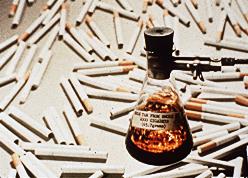
The bottle above with the tar collected from 2,000 cigarettes. If a diluted form (diluted, not concentrated is as often done in animal experimentation to demostrate that chemicals are carcinogens) of this tar is painted on the skin of mice, 60% of the animals developed cancer of the skin within a year. 
Many chemicals currently banned for human consumption were removed from usage if they even caused 5% or less cases of cancer in similar experiments. Cigarette tars contain some of the most carcinogenic chemicals known to man. Consider this when watching people smoking and exhaling only 10% of the tars they actually take in. Not only are these chemicals being painted into the lung, but smoker are also constantly painting them up on their lips, tongue, larynx, swallowing some and thus painting it in the esophagus and throughout the digestive tract. Smokers have increased incidents of cancer in all of these exposed sites. Now that you know what it looks like on a large scale and feels like, lets take a look at the microscopic level of things that happen in the lung from smoking. The following series of slides illustrate microscopic changes that happen when a person smokes. The first slide is showing an illustrated blow-up of the normal lining of the bronchus. 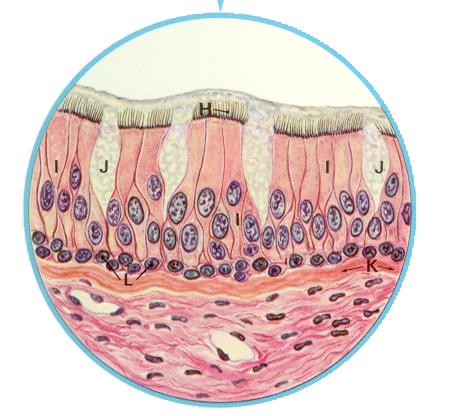
On the top we see the cilia, labeled (H). They are attached to columnar cells, labeled (I). The cilia sweep the mucous produced in the goblet cells, labeled (J) as well as mucous coming from deeper glands within the lungs and the particulate matter trapped in the mucous. The bottom layer of cells, labeled (L) are the basal cells. Below we start to see the changes that occur as people begin to smoke. You will see that the columnar cells are starting to be crowded out and displaced by additional layers of basal cells. Not only are fewer cilia present but the ones that are still functioning are doing so at a much lower level of efficiency. Many chemicals in tobacco smoke are toxic to cilia, first slowing them down, soon paralyzing them all together and then destroying them. 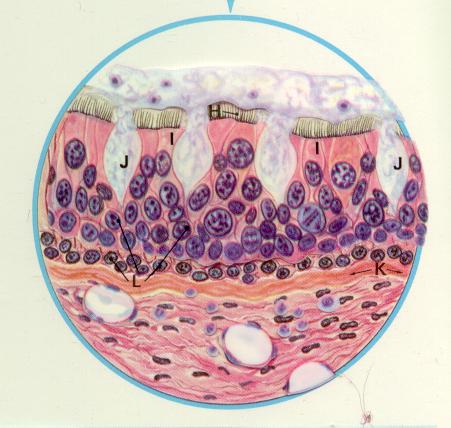
As you see with the cilia actions being diminished, mucous starts to build up in the small airways making it harder for the smoker to breathe and causing the characteristic smokers cough in order to clear out the airways. Eventually though, the ciliated columnar cells are totally displaced. As can be seen below ominous changes have taken place. Not only is the smoker more prone to infection from the loss of the cleansing mechanism of the cilia, but these abnormal cells (O) are cancerous squamous cells. These cells will eventually break through the basement membrane wall and invade into underlying lung tissue and often spread throughout the body long before the person even knows they have the disease. 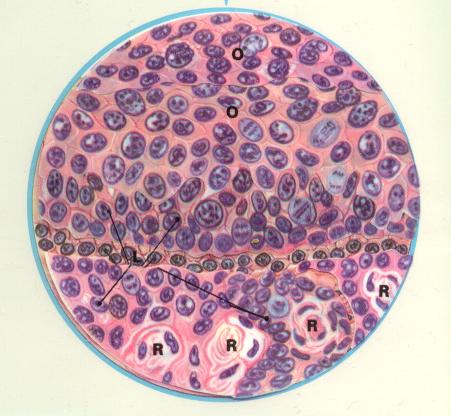
If a smoker quits before cancer actually starts, even if the cells are in a precancerous state, the process is highly reversible. Cilia regeneration starts in about 3 days once smoking stops. Even if cilia has been destroyed and not present for years, the lining tissue of the windpipe will start to repair. Even the precancerous cells will be sloughed off over time, reversing the cellular process to the point where the lining tissue goes back to normal. But if a smoker waits too long and cancer starts, it may be too late to save his or her life. Following are actual pathological slides showing these same damaging effects. 
The little pink hairlike projections on the top is the cilia and if you compare this image with the illustrations above you should be able to see the mucous secreting cells and the separation of the lining tissue from the underlying lung tissue. Below you can see the same area of tissue from a smoker's lung who has totally destroyed the cilia in this tissue. 
Again note, where there used to be two layers of well formed and orginized basal cells, now numerous layers of disorganized squamous cells has replaced the normal defensive tissue. These cells are precancerous and if the continued irritation (cigarette smoke) is not ceased can go to that final stage where they become malignant and invade into the underlying lunng tissue as seen below. 
Then it is only a matter of time before it leaves the lung and spreads throughout the body. If the smoker quits smoking before this last cellular change occurs, before a cell turns malignant, the process seen in this last slide can be avoided. In fact much of the damage seen in the second picture here is highly reversible. In three days cilia start to regenerate and usually within 6 months the normal cilia function is returned. Also over time, the extra layers of cells will be sloughed off and the lining tissue of the bronchus will return to normal. Unfortunately, if a smoker waits until a malignancy has started, the outlook is grim. The overall 5 year survival rate for lung cancer is only 14%. Lung cancer, is a disease that while once uncommon, is now the leading cancer killer in both sexes. Cancer is actually many different diseases with many different causes. If we look at cancer trends over the last century we see some amazing changes. While cancer was always around, it was different sites that were primary problems. Lung cancer, at the turn of the century was almost unheard of. If a doctor saw a case he would have easily gotten it printed up in a medical journal. Now, it is the major cause of cancer death in our society, killing more men and women than any other site. The primary difference between now and then is smoking. Before the turn of the century smoking was a limited practice. A very small percentage of people smoked and even the ones who did smoked many fewer cigarettes. Cigarettes were not even mass produced till the very end of the 1900’s. We always hear of a cancer epidemic, how more and more people die of cancer every year. Actually, if you pull the smoking related sites out of the equation, cancer deaths have been on a decline. Some sites, like stomach the incidence dropped dramatically, not fully understood as to why. Other sites, like breast, even though the morbidity rate (number of cases) didn't drop, because we now have better treatments and earlier detection, the mortality (death) rate has dropped. But the smoking cancers; lung, mouth, lip, tongue, throat, larynx, pancreas, esophagus, pharynx, urinary bladder have all seen marked increases over the 20th century. These cancers have gone from obscurity to some of the major causes of death in our country. Actually, for the first time in a hundred years we are starting to see an early decline of morbidity and mortality because we are seeing fewer smokers now with the drop in the percentages of adult smokers. 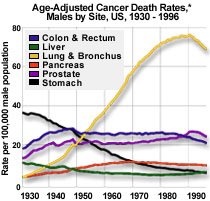
Men
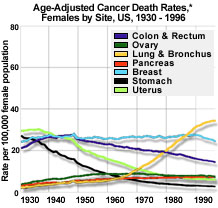
women
You see a dramatic difference in men and women, especially in lung cancer rates. The reason is women started smoking much later than men, about a 30 year time delay before it became socially acceptable for women to smoke. Male smoking rate jumped dramatically between World War I and another big boost during World War II. Free distribution of cigarettes to soldiers was a big factor. Women smoking rates happened much later and the time delay is reflected in the time delay in cancer and otehr diseases going up too. The above pictures were primarily about how smoking causes cancer of the lung and other sites. But the assault on the lungs from the tars in tobacco are not just limited to causing cancer. Other lung diseases are directly caused by smoking, the most well known are the chronic obstructive lung diseases. The most well known smoking induced COPD is emphysema. This is another one of those diseases that primarily happen to smokers. Over 90% of the cases are smoking induced. There are cases in some families where there does seem to be a genetic predisposition, where non-smokers get it too. This is from a rare condition, a lack of a blood enzyme called alpha1antitrypsin. This again is rare, but if you do have family members who never smoked a day in their life get emphysema there may be a genetic tendency. But again, over 90% of emphysema cases are simply caused by smoking. Eradicate smoking and you eradicate the risk of the disease. To get a sense of how a long is altered by smoking to cause emphsema look at the pictures below. The first is a picture of an inflated non-smoker city dweller's lung. 
As in the normal picture of a lung above, you can see carbon deposits collected throughout from pollution effects. But when contrasted with a smoker's lung with emphysema... 
...there is a very dramatic visible difference. Not only is the discoloration the issue, but the lungs have literally been ripped out of shape making breathing extremely difficult and eventually impossible. To get a sense of what it feels like to breathe with emphysema take a deep breath and hold it. Without letting out any air, take another deep breath. Hold that one too. One more time, take one more breath. Okay let it all out. That second or third breath is what it feels like to breathe when you have advanced emphysema. Emphysema is a disease where you cannot exhale air. Everyone thinks that it is a disease where you cannot inhale but in fact it is the opposite. When you smoke you destroy the lungs elasticity by destroying the tissue that pulls your lung back together after using muscles that allow us to inhale air. So when it comes time to take your next breath it is that much more difficult, for your lungs could not get back to their original shape. Imagine going through life having to struggle to breathe like those last two breaths I had you take. Unfortunately, millions of people don't have to imagine it, they live it daily. It is a miserable way to live and a slow painful way to die. Hopefully when you breathe normally today you are not in pain and you are not on oxygen. If you don't smoke you will continue to give yourself the ability to breathe longer and feel better. Never lose sight of this fact. To keep your ability to breathe better for the rest of your life always remember to - NEVER TAKE ANOTHER PUFF! Joel |
|
Reply
 | | | From: Joel | Sent: 10/11/2006 1:13 PM |
Offers for cigarettes If ever you have a family member, friend, co-worker or any other acquaintance offer you a cigarette it is best to politely say no and just let the person know that you do not smoke any more nor do you even want to smoke any more. Basically say you have no interest or desire for one. That should be the end of the offers if it is from any person who was just making what he or she thought was a friendly gesture. If the person pursues asking you about how you quit and why you feel as you do, you may want to take the opportunity to share some of what you learned here about how important quitting smoking is and how much better you feel about yourself since you have quit smoking. If on the other hand the person continues to offer you a cigarette or is obviously actually pushing you to take one it is best to give it one or two more tries to politely say no and ask the person not to offer any more for you truly have no intention of smoking one. If this doesn't end the pressure being put on you to take a cigarette it is time to change your tactics. Look at the person, maybe even with a little bit of sadness and defeat in your eyes, and say to him or her that you can't take the pressure anymore and sure give me a cigarette if you must. When he or she hands you the cigarette, walk over to the nearest garbage can, crumble it up and throw it out. Now you have an option of how you want to proceed. You can either wait for the next offer to come or you can say, "Thank you, that felt great. Would you like to give me another one." If the person is gullible enough to offer you another take that one too and repeat the destruction and disposal. Keep it up for as long as the person keeps offering. At some point you may want to say that this could go a whole lot faster if you would like to give me your pack. You can destroy all of the cigarettes that way in one fell swoop. I can assure you that if you stick to this game plan the person is eventually going to stop offering you cigarettes. Cigarettes are just to expensive to keep up this kind of routine over a long time period. By the way, you should not feel any guilt for destroying the cigarettes of another person. Once a person is offering you a cigarette he or she should not be expecting to get it back. If you smoke the cigarette it is no longer available for the person or if you destroy the cigarette it is no longer available either. If the person is indeed making the offer to somehow give you some sort of pleasure the odds are you will get some sort of pleasure out of destroying them. If not pleasure you should get a little amusement out of the reaction from the person as they see their hard fought efforts to get you to smoke get instantly trashed. This action will likely result in the other person feeling a whole lot more irritated by the altercation than you will. More importantly though, you will by example be proving to the person and to yourself that your quit is strong and your resolve is totally intact to stick to your personal commitment to never take another puff. Joel I wrote the above article specifically about people offering you cigarettes after you quit. Another similar issue is for people who repeatedly "accidentally" leave their cigarettes in your home, office or car. If this ever happens it is best to destroy the person's cigarettes. Again, the same concept applies--whether you smoke them or destroy them, the cigarettes are no longer going to be available for the person who has carelessly left them behind. The first time if you really feel bad you can reimburse the person the cost of the cigarettes. After that though the person should clearly know not to be so careless with his or her cigarettes. |
|
Reply
 | | | From: Joel | Sent: 10/11/2006 1:13 PM |
Quitting for Others
"My husband can't stand it when I smoke - that is why I quit." "My wife is trying to quit, so I will stop just to support her." "My kids get sick when I smoke in front of them. They cough, sneeze, and nag me to death. I quit for them." "My doctor told me not to smoke as long as I am his patient, so I quit to get him off my back." "I quit for my dog." All these people may have given up smoking, but they have done it for the wrong reason. While they may have gotten through the initial withdrawal process, if they don't change their primary motivation for abstaining from smoking, they will inevitably relapse. Contrary to popular belief, the important measure of success in smoking cessation is not getting off of cigarettes, but rather the ability to stay off. A smoker may quit temporarily for the sake of a significant other, but he will feel as if he is depriving himself of something he truly wants. This feeling of deprivation will ultimately cause him to return to smoking. All that has to happen is for the person who he quit for to do something wrong, or just disappoint him. His response will be, "I deprived myself of my cigarettes for you and look how you pay me back! I'll show you, I will take a cigarette!" He will show them nothing. He is the one who will return to smoking and suffer the consequences. He will either smoke until it kills him or have to quit again. Neither alternative will be pleasant. It is imperative for him to come to the realization that the primary benefactor in his giving up smoking is himself. True, his family and friends will benefit, but he will feel happier, healthier, calmer and in control of his life. This results in pride and a greatly improved self-esteem. Instead of feeling deprived of cigarettes, he will feel good about himself and appreciative to have been able to break free from such a dirty, deadly, powerful addiction. So, always keep in mind that you quit smoking for you. Even if no one else offers praise or encouragement, pat yourself on the back for taking such good care of yourself. Realize how good you are to yourself for having broken free from such a destructive addiction. Be proud and remember - NEVER TAKE ANOTHER PUFF!
|
|
Reply
 | | | From: Joel | Sent: 10/11/2006 1:14 PM |
My Support Group is Responsible!
| Case 1: | Case 2: | | “How do you expect me to quit smoking? All of my family, friends, and work associates smoke. Whenever I try to quit they all try to sabotage my efforts. With support like that, I can't quit smoking!�?/B> | “I know I will quit. Nobody wants me to smoke. My kids beg me to stop, my husband hates it when I smoke, and we're not allowed to smoke at work. I feel like a social outcast wherever I go. With all those people on my back, I know I won't fail in quitting!�?/B> |
In both of the above cases, the smoker is wrong in their assessment of whether or not they can actually quit smoking. Success in quitting smoking is not primarily determined by significant others. It is based on the strength of the smoker's own desire to quit. In case one, the smoker is blaming his failure on lack of support and actual sabotage attempts by others. But not one of these people physically forced a lit cigarette into his mouth and made him inhale. Considering that the only way he could reinforce his nicotine addiction is by inhaling a cigarette, none of his smoking associates had the final say on his success or failure. Case two, on the other hand, was working under the false assumption that quitting smoking would be a breeze since everybody would support her because they hated her smoking. Not once, though, did she say that she actually wanted to stop for herself. She was stopping because everyone else wanted her to. In essence, she was depriving herself of her cigarettes to make everybody else happy. While she may not have lit up when surrounded by others, sooner or later she would be alone. With no one around, what personal reason does she have to strengthen her resolve not to take a cigarette? When you joined our clinic, you may have initially blamed others for your failure or erroneously credited the clinic and others with your success. No one failed or succeeded for you. You did it. While significant others can influence how easy or difficult quitting will be, your own personal resolve is the major determinant of success or failure. If you failed when you tried in the past, stop blaming others. Realize that your personal desire to stop was not strong enough to overcome the powerful grip cigarettes exerted on you. Rather than making one half hearted attempt after another, make a personal assessment of why you smoke and why you wish to stop. If your personal reasons are good enough, then try to stop. As long as your ammunition is strong, no one will be able to make you smoke. On the other hand, if you quit, don't feel that the clinic or any one else made you do it. You broke free from a powerful addiction. You did it by making up your own mind, throwing out your cigarettes, and refusing to take another one no matter how much temptation you faced. For this you should be proud. And to maintain that pride for the rest of your life - NEVER TAKE ANOTHER PUFF!
|
|
Reply
 | | | From: Joel | Sent: 10/11/2006 1:16 PM |
Setting Quit Dates
Conventional wisdom in smoking cessation circles says that people should make plans and preparations for some unspecified future time to quit. Most people think that when others quit smoking that they must have put a lot of time into preparations and planning, setting quit dates and following stringent protocols until the magic day arrives. When it comes down to it, this kind of action plan is rarely seen in real world quitters. I emphasize the term real world quitters as opposed to people quitting in the virtual world of the Internet. People who seek out and participate in Internet sites do at times spend an inordinate amount of time reading and planning about their quits before taking the plunge. Even at our site we see people say they were reading here for weeks or months before finally quitting and joining up. Although I suspect there are a fair number of people who had already decided to quit right away and searched us out after their quit had begun, and some people who may not have actually decided to quit but who when finding WhyQuit.com and seeing cigarettes for what they are decided then and there to start their quits. Getting back to real world experience though, the best people to talk to when it comes to quitting smoking are those who have successfully quit and have successfully stayed off for a significant period of time. These are people who have proven that their technique in quitting was viable considering they have quit and they are still smoke free. Talk to everyone you know who is off all nicotine for a year or longer and find out how they initially quit smoking. You will be amazed at the consistency of the answer you get if you perform that little survey. People are going to pretty much fall into one of three categories of stories. They are: -
People who awoke one day and were suddenly sick and tired of smoking. They tossed them that day and never looked back. -
People who get sick. Not smoking sick, meaning some kind of catastrophic smoking induced illness. Just people who get a cold or a flu and feel miserable. They feel too sick to smoke, they may feel too sick to eat. They are down with the infection for two or three days, start to get better and then realize that they have a few days down without smoking and decide to try to keep it going. Again, they never look back and stuck with their new commitment. -
People who leave a doctors office who have been given an ultimatum. Quit smoking or drop dead--it's your choice. These are people for whom some sort of problem has been identified by their doctors, who lay out in no uncertain terms that the person's life is at risk now if they do not quit smoking. All of these stories share one thing in common--the technique that people use to quit. They simply quit smoking one day. The reasons they quit varied but the technique they used was basically the same. If you examine each of the three scenarios you will also see that none of them lend themselves to long-term planning--they are spur of the moment decisions elicited by some external circumstance. I really do encourage all people to do this survey, talking to long- term ex-smokers in their real world, people who they knew when they were smokers, who they knew when they quit and who they still know as ex- smokers. The more people do this the more obvious it will become how people quit smoking and how people stay off of smoking. Again, people quit smoking by simply quitting smoking and people stay off of smoking by simply knowing that to stay smoke free that they must never take another puff! Joel © Joel Spitzer 2006 Page created February 19, 2006 and last updated by Joel Spitzer on February 19, 2006
The British Medical Journal reported an interesting study that tied into this article very well. Here is a link to the abstract of that study: http://bmj.bmjjournals.com/cgi/content/abstract/bmj.38723.573866.AEv1 I wrote a reply to the journal that got posted on their response website. Here is a link to that reply: http://bmj.bmjjournals.com/cgi/eletters/bmj.38723.573866.AEv1#127706 That commentary elicited a reply from another person, who was basically trying to give the impression that serious scientists shouldn't put too much emphasis on real world experiences. I wrote a reply to this editorial but it somehow did not seem to get past the editorial review board at the British Medical Journal. I think the reply is still valid so I am attaching it below:
|
| | Joel Spitzer,
Health Educator
Conduct Stop Smoking Clinics for the Evanston and the Skokie Illinois Health Departments 60201,60076 Send response to journal:
Re: Re: Flawed reasoning
| "...because something commonly happens in a particular way 'in the real world' then this should be considered the best way." Smoking cessation experts often seem to have to be telling people to dismiss real world experiences. Usually I see a little different variation of the comment above. Common statements I have seen are something to the effects that while it is likely that a person may at times encounter real world quitters who succeeded by using non-recommended techniques, usually meaning no pharmaceutical intervention or in what this study is showing, people who used no set quitting date, that these people are just the exceptional cases. What the experts are trying to do in effect is discredit observations made by people, making them think that the occurrence of such experiences are really rare. The author above was at least accurate enough to say, "While it is true that most smokers who quit do so without any specific behavioral support or pharmacological treatment..." The rest of the comment was going on to try to give the impression that there would have been even more successful quitters if people would just do what smoking cessation experts say should work as opposed to doing what actual quitters continually say has worked for them. The tactic being employed here is to leave the impression that we could just have a whole lot more successful quitters if people would just utilize the miraculous effective products out there that actually help people to quit. There is also the perception being portrayed that there really are very few ex-smokers out there because most who have tried to quit have done so unaided and everyone just knows how improbable it is for people to be able to quit in an unaided attempt. Medical professionals and the general public are being misled to believe that quitting smoking is just too plain difficult for people to do on their own and that the odds of a person actually quitting on their own is really pretty dismal. This would all make perfect sense if not for the fact that we have so many successful ex-smokers in the real world. In America, we have more former smokers than current smokers. Over half of the people who used to smoke have now quit smoking. From the comment made above it should be clear to all that most of the people who have quit either did not know of professional recommendations for quitting or chose to ignore professional intervention techniques. Yet these people successfully quit anyway. I think that this is an important point to hit home with all medical professionals. The medical profession has got to start to help people to realize the real potential of success that individuals do have to quit smoking instead of perpetuating the idea that quitting is just too hard for an individual smoker to expect to actually succeed without help. While this article should have been about planning techniques, the original author and a few experts weighing in on the discussion have tried to turn it into a referendum on selling pharmaceutical interventions. Nicotine replacement products have been around for over two decades now-- and a significant percentage of smokers have used them to try to quit smoking. If a product has been around for decades, used by millions of people worldwide, AND, has been truly effective, it should be easy for most health care practitioners to come up with lots and lots of successful patients, colleagues, family members and friends who have quit with these products. As I said in my original commentary above: " I don't believe that there is a single professional smoking cessation "plan your quit" advocate who will suggest other medical professionals should take a similar survey. For if they did their study results would almost certainly be called into question when the health care professional starts seeing the results of his or her real life survey. The experts will end up having to spend quite a bit of time trying to explain away the discrepancy, using rationalizations like the people who planned their quit "didn't do it right" or didn't "plan" long enough or were "just more addicted smokers." In all honesty, I don't expect my encouraging of real world observations by health care professionals to have much impact with smoking cessation experts. They are going to profess to believe whatever other experts keep telling them to believe or, what the funders of their studies believe. I do however believe that health care workers who are on the front line and actually deal with patients who smoke are going to be a bit more critical and analytical about this. If they spend any time talking with patients they are going to see through the rhetoric and the rationalizations of the experts. I have always tried to disseminate the message that just because something works in the lab or in study conditions doesn't necessarily translate to the fact that the process will work in the real world. The smoking cessation experts seem to have to work on the basis that just because something works in the real world doesn't mean that it is a good approach if it doesn't seem to work in a lab. I have high hopes that medical professionals really wanting to help their patients are going to be more influenced by what they see is successful than by being told by the experts what should be successful, but somehow not replicable in their own practices. | |
|
 First First
 Previous
2-8 of 9
Next Previous
2-8 of 9
Next Last
Last
|
|
|
 Free Forum Hosting
Free Forum Hosting